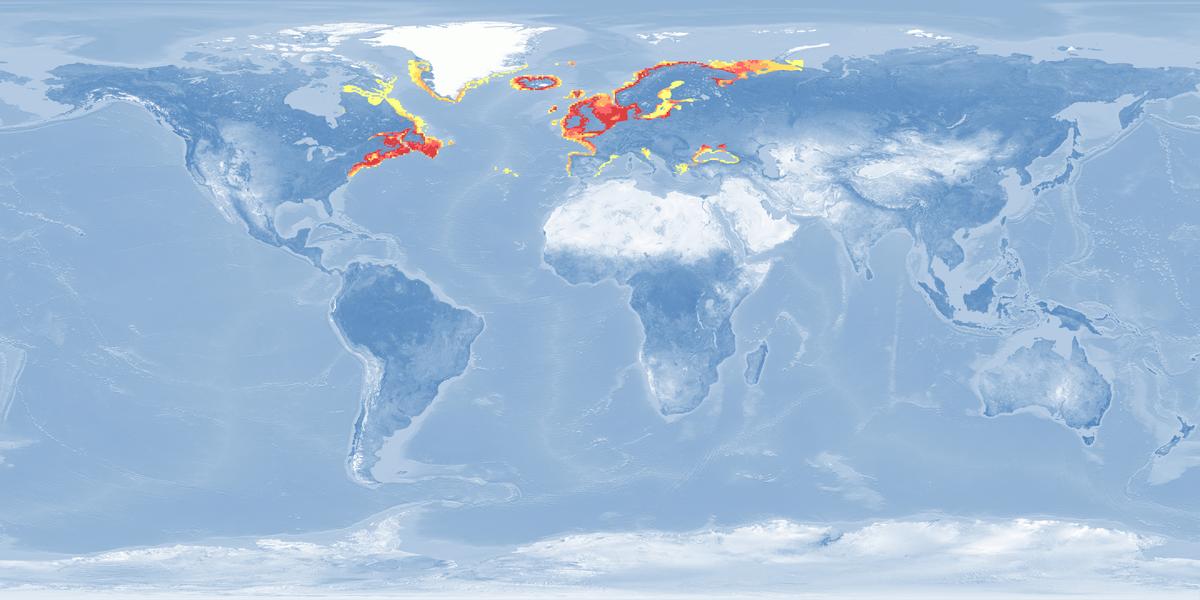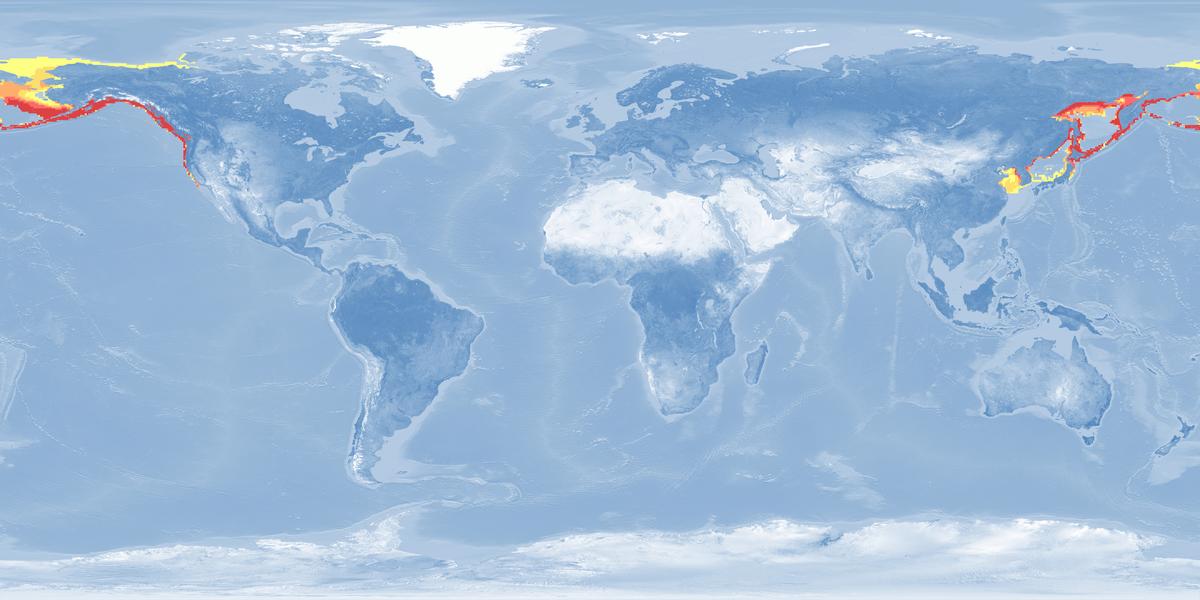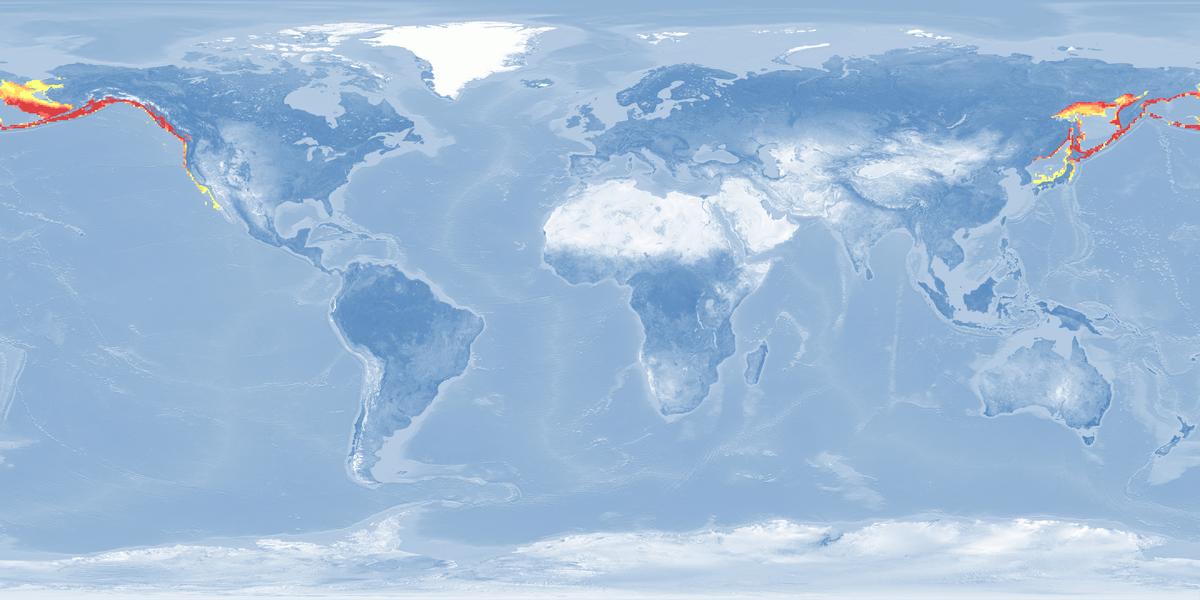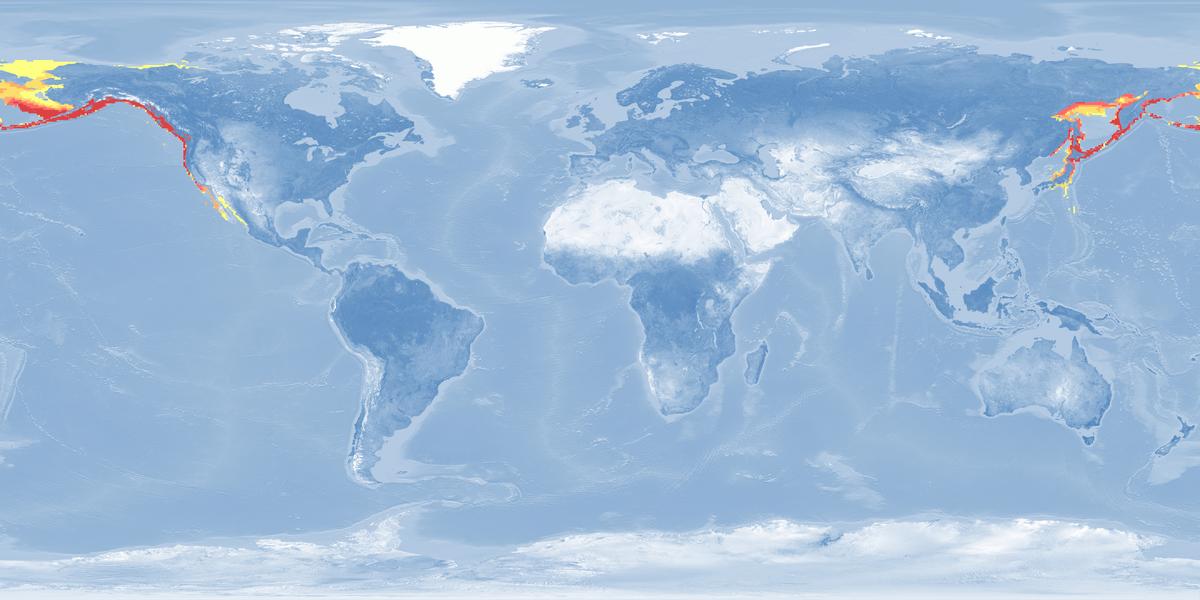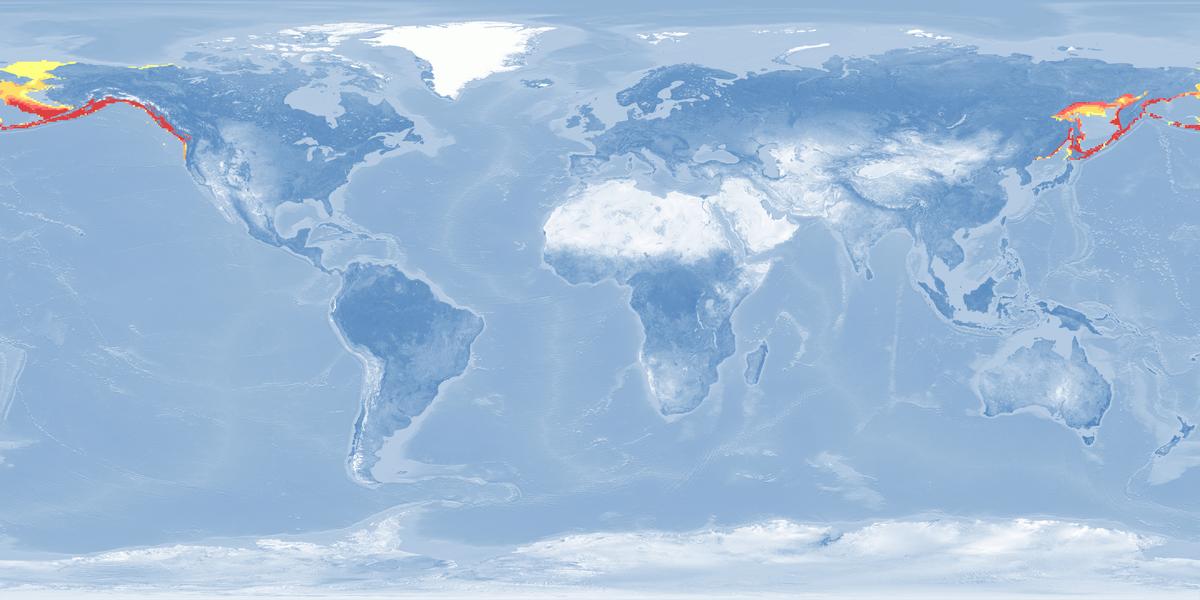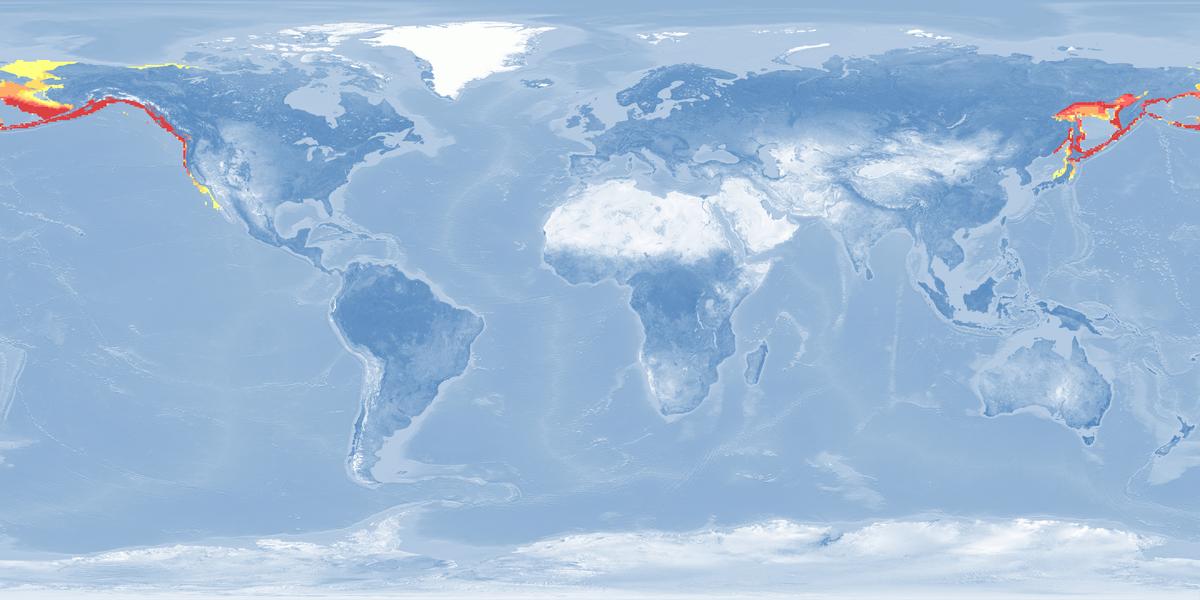Sake Sushi
Salmon
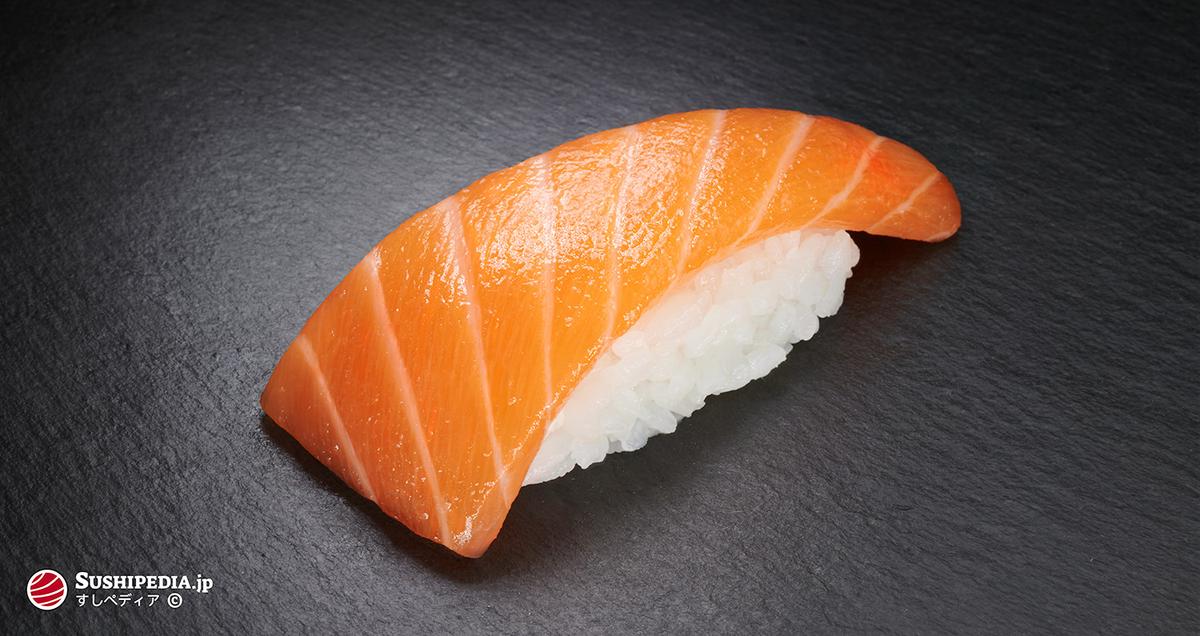
What is Sake (Salmon)?
Sake-rui (サケ類) is the Japanese generic term for fishes belonging to the family of salmonids. In a narrower sense, the Japanese term sake refers to the pacific salmons, especially to chuma salmon (shirosake, シロザケ), in a broader sense, the term refers to a category of salmon fish that bear the term sake in their name and whose meat is similar in color and texture to that of chum salmon. Traditionally, these fish have been classified as belonging to the sake group if they spend most of their lives in salt water.
Only since modern times salmon is prepared as sushi to the extent we know it today. Traditionally, salmon was rarely used for the preparation of sushi or sashimi. Even though the term sake traditionally refers to Pacific salmons, today it is mainly the Atlantic salmon from aquaculture that is used.
Salmon is one of the most popular ingredients for sushi and sashimi these days. However, more than one species is suitable for the preparation. In Japan, imported salmon is sometimes referred to as sāmon (サモン) rather than sake (サケ).
Sake as Ingredient for Sushi or Sashimi
Salmon and trout fish are nowadays found in many common sushi restaurants, whereas purists and high class sushi restaurants refrain from preparing sake for reasons of tradition as well as its reputation as a cheap fish.
The characteristic color of salmon meat is striking. Depending on the species, origin and food, the color palette ranges from a pale pink to a rich red to a light shade of orange. The actual color of the salmon meat is grayish, it gets its distinctive color from the composition of the food it consumes. Salmon prefer beside small fishes especially amphipods and shrimps. These in turn feed on green algae, which produce xanthine, a natural reddish-purple dye. This dye accumulates in the meat of the salmon fish and gives it its unmistakable color. The meat is greasy, extraordinarily tender and is accompanied by intense buttery flavors. The intensity and texture of sake meat differs between species and also whether they are farmed or wild. For the preparation of sushi or sashimi, it is recommended to prefer hand-filleted salmon to that from industrial processing. Visible cracks in the meat are caused by the partial or fully automatic extraction of the standing bones. These are not only visually unattractive, but also provide an environment for bacteria. Condensation water can collect in the cuts and cracks, which promotes the reproduction of bacteria during the decomposition process. For the preparation of sushi or sashimi, the middle or front piece of a salmon side from a freshly hand-filleted specimen is best suited.
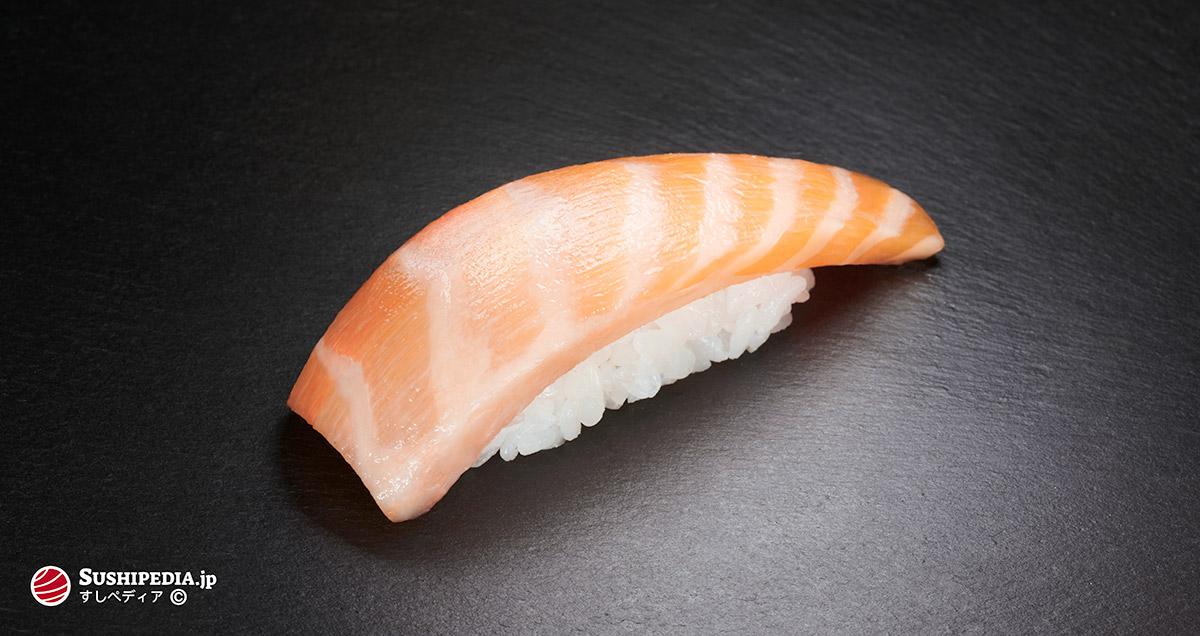
By sprinkling the pieces with a some salt after filleting (furijio, 振り塩) and then storing them in a cool place for up to 30 minutes, the meat loses moisture and some odor. In turn, the texture becomes firmer and the flavor intensifies [Onodera, 2020]. .
Best season
Depending on the species of salmon, the spawning time varies according to the region to which they return to lay eggs. Basically one can say that the cold season is the best time for wild caught specimens. Salmon from aquaculture, on the other hand, is available all year round in consistent quality.
Wild capture vs. aquaculture
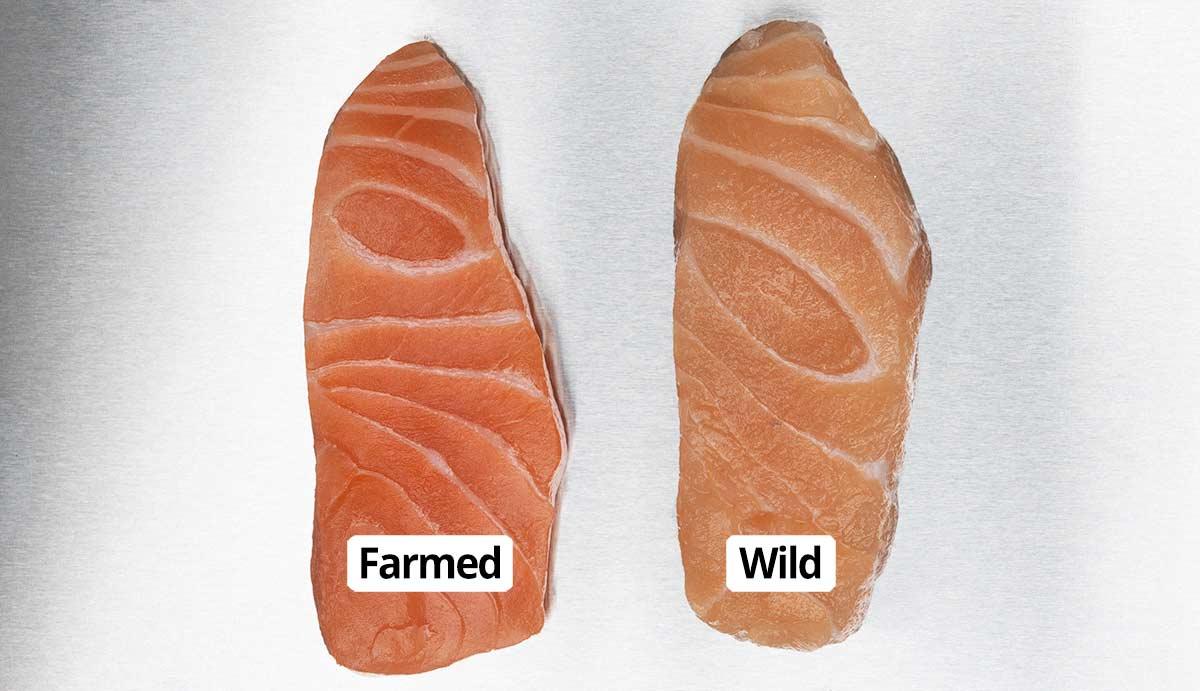
Salmon meat has a distinctive and strong flavor regardless of whether they come from farmed or wild stocks. The meat of salmon from aquaculture is usually richer in fat than that of wild caught salmon. Especially during the summer season, farmed salmon is higher in fat and accordingly tastes richer than wild salmon. The taste of the meat of wild salmon, on the other hand, is more aromatic and complex.
It is not always possible to distinguish between farmed and wild salmon by color, the shade of the meat does not always provide a valid indication, as it can be controlled by the addition of colorants in the feed. In most cases, the meat of farmed salmon has a visibly higher fat content of the muscle separating layers, which makes the characteristic light-colored stripes of the tissue appear wider and brighter. However, the actual difference is smaller than is often claimed in the popular literature, since for an adequate comparison, identically cut fillets of fish of the same age from the same species are rarely used.
With regard to raw consumption, i.e. the preparation of sushi and sashimi, it is recommended to choose sustainable and high quality farmed salmon. When wild salmon is used, it is recommended that it be prepared from pre-rigor deep frozen salmon that has been thawed before preparation. The complete freezing process kills all parasites, but they remain in the meat.
Origin
Various sources, be it chefs, fishmongers or advertising brochures, claim that farmed salmon from Scotland or Ireland is more valuable than Norwegian salmon or vice versa. The above countries can be interchanged at will with other major industrial salmon farming nations in such advertising claims. If it is the same type of salmon, mostly atlantic salmon, this assessment is purely subjective. The quality of the salmon is largely dependent on the expertise of the farm or producer and is influenced by various factors, such as the composition of the feed, chemical use, stocking density and water quality.
A good indicator of high quality can be, but does not necessarily have to be, the certification of the farm with an organic or ecological label.
Types of Sake (Salmon)
Atlantic Salmon
Atlantic salmon, in Japanese taiseiyousake, is the economically most important salmon species, whose wild stocks were heavily overfished for decades. Today, almost 100% of all commercially traded Atlantic salmon comes from farms, the majority of which come from Norway and Chile.
Farmed Atlantic salmon has a high fat content and is milder in taste compared to its Pacific relatives. The consistency and texture of the meat depends on the quality of the farms and the meat processing. It is estimated to be one of the most widely used salmon species in the world for the preparation of sushi or sashimi.
Red or Sockeye Salmon
The sockeye salmon, benizake in Japanese, is only available as a wild catch. There is no commercially relevant aquaculture. The name is derived from the fact that its skin changes its color from light silver to a bright red during its migration upstream to spawn. The English name “sockeye” is an anglicisation of suk kegh (sθə́qəy̓), its name in Halkomelem, the language of the Indian tribes at the lower reaches of the Fraser River and means “red fish” [William, 2004].
Thanks to its dark red, firm and juicy meat, red salmon is a very popular ingredient, especially when smoked or salted. Red salmon enjoys a very good reputation in top gastronomy and is accordingly traded at high prices. Even though red salmon is rarely used for sushi or sashimi, its meat is excellent because of its good taste. Thanks to its firm structure, the meat retains an appealing texture even after freezing and thawing, which is essential for raw consumption, and rewards with a full-bodied but not overly intrusive taste.
Chum, Keta or Dog Salmon
In Japan, the name sake traditionally refers to the chum salmon, whose name comes from the Chinook jargon tzum, which means "spotted", while keta comes from the East Siberian language of the Evenks. Although his name in Japanese is actually Shirozake, the Japanese traditionally refer to him when they mention Sake. In Japan, juveniles of the chum salom are called keji (ケイジ) and have a particularly high fat content. Chum salmon caught between May and July are called tokishirazu (トキシラズ) or tokizake (時鮭) and are considered the tastiest. Shirozake that are about to spawn are called bunazake (ブナザケ) and are very popular because of their roe. Of all the salmon species, the roe of chum salmon, is considered the most prized for making ikura.
The chum salmon meat is light to medium in color and has less fat than that of other salmon species. The fat content depends on the season and the size of the animal. Besides imported Atlantic salmon from aquaculture, the solely wild caught chum salmon is the salmon most commonly used for Sushi in Japan. To kill possible parasites, the wild caught chum salmon must be frozen sufficiently.
Chinook or King Salmon
The biggest type of the Pacific salmon is the chinook salmon, whose Japanese name is Masunosuke or Kingusāmon. The chinook salmon is valued mainly for its comparatively high fat content and correspondingly tasty meat. A small number of chinook salmon are caught during their migration along the Pacific coast off Hokkaido, the largest catch areas are in the North Pacific and Alaska. More than 80% of the world's chinook salmon is aquaculture, the majority of which is produced in New Zealand.
The chinook salmon has the reputation of being the tastiest of the Pacific salmon species next to the red salmon. The meat is very tender, full-bodied in taste and has an appealing intense coloration. For those who prefer sake sushi or sashimi with an intense and buttery taste, chinook salmon is an ideal ingredient.
Pink or Humpback Salmon
The humpback salmon owes its name to the high hump, that the sexually mature male fish develop between the head and the back-fin at the spawn-time. The males develop a strong pink coloration during the mating season, which is why they are also called pink salmon. The spread-area stretches over the coast-regions of the North-Pacific, from Alaska over California as far as to Russia and Japan. From its Japanese name karafutomasu it can be seen that the pink salmon is traditionally counted among the trout (masu) in Japan, while its modern name in Japan is pinkusāmon.
Compared to other salmon species, the pink to orange colored meat is comparatively lean and milder in taste. Over 99% of the pink salmon is caught wild. Russia and the United States of America are among the largest fishing nations. The meat of the pink salmon is rarely used in Japan for the preparation of sushi and sashimi. Most of the salmon caught in Japan is processed into canned or salted trout (shiomasu, 塩マス).
Silver or Coho Salmon
Coho salmon, known in Japan as ginzake, are appreciated by many chefs and cuisines, whose populations are regarded as overfished. The natural habitat of the coho salmon extends along the North Pacific coasts from Japan to Russia and California. More than 85% of the world's coho salmon comes from aquaculture, the vast majority of which, almost 90%, is farmed in Chile.
In Japan, coho salmon is a popular substitute for chum and sockeye salmon, which is mainly used as salted fish (shiozake), fillet and as filling for rice balls (onigiri). The meat of farmed coho salmon is greasy, tasty and has a very pleasant smell and is well suited for the preparation of sushi and sashimi.
Sea, Coastal or Salmon Trout
The sea trout is a trout caught in the sea or farmed, whose meat is pink, orange to red in color. The name applies to varieties of the brown trout (Salmo trutta) and rainbow trout (Oncorhynchus mykiss). The steelhead trout is an anadromous form of the coastal rainbow trout or brown trout, which is very popular among chefs. The coloration of the meat results from the food ingested by the fish, which in the case of animals caught in the sea is due to the composition of certain crustaceans and in the case of farmed fish to the addition of colorants in the feed.
Salmon trout, especially from maritime breeding, are popular for the preparation of various dishes and serve to a certain extent as a substitute for salmon. The farmed salmon trout is richer in fat than the common trout, but leaner than the salmon and therefore also suitable for the preparation of sushi and sashimi.
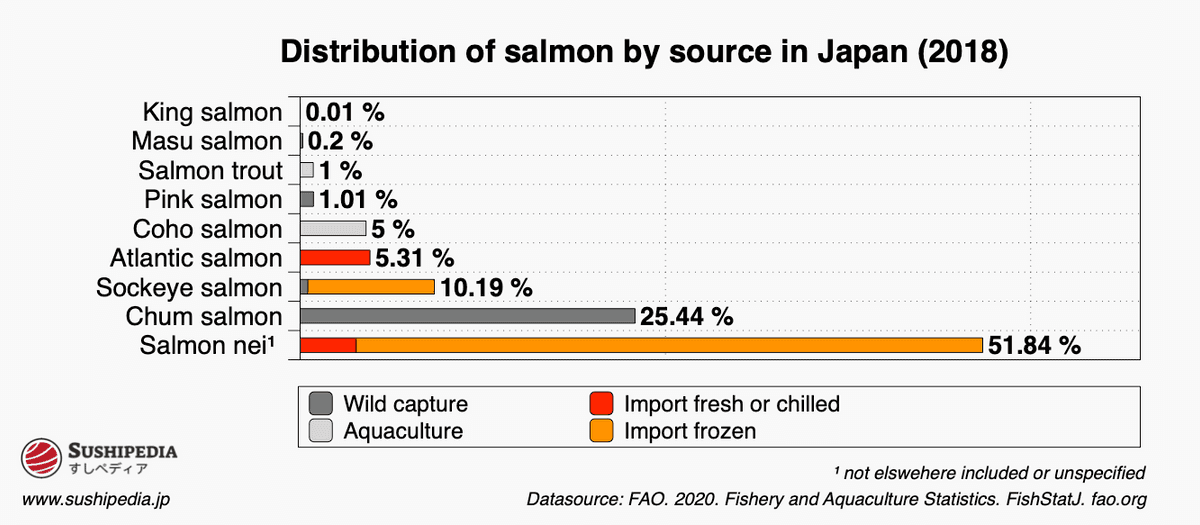
Sake in Japan
Grilled salmon is a component of many traditional Japanese dishes. Due to the high risk of wild caught salmon being too heavily infested with parasites harmful to humans, raw consumption was abandoned for a long time. Only since the introduction of farmed salmon from Norway and Chile on the Japanese market, salmon has become an integral part of modern sushi gastronomy.
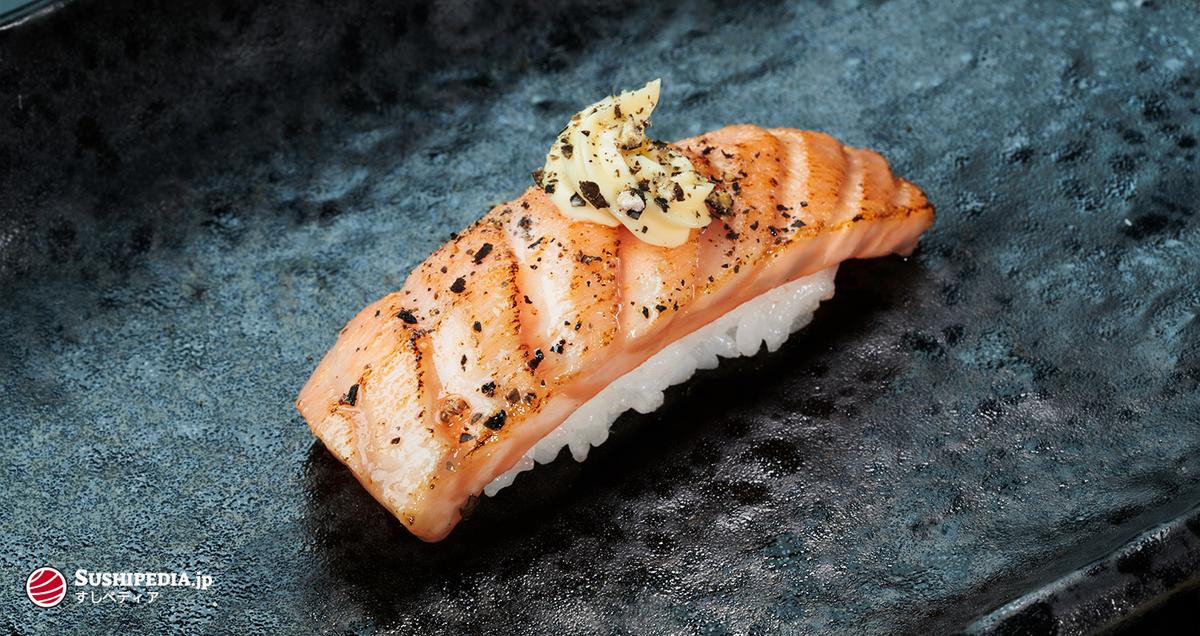
Project Japan
The success of salmon as ingredient for sushi or sashimi in Japan can be traced back to a joint project between Norwegian industry and the Ministry of Fisheries. The initiation of “Project Japan”, a carefully executed marketing campaign to establish Atlantic salmon in Japan, laid the foundation for the current popularity of sake sushi and sashimi.
“Everybody said ‘we do not eat raw salmon.’ We had to really fight to introduce salmon into the market [...] It took 15 years from when the first salmon went to Japan (in 1980) to the breakthrough for raw consumption in 1995.
- Nortrage.com [Soysal, 2014]
Due to the increasing production of farmed salmon, Norway faced a rapidly growing production surplus in the early 1980s. In Japan, on the other hand, the demand for high-quality fresh fish, especially tuna, for the preparation of sushi or sashimi increased at that time. Japanese and Russian chum salmon were already used in large quantities for smoking, salting and drying, but not for raw consumption. At the end of the 1980s, Norway invested large sums in campaigns to inform Japanese consumers, food retailers and gastronomes about the taste benefits of their product. Until then, salmon in Japan had been considered unsuitable for raw consumption and susceptible to parasites that are harmful to humans. In the long term, the campaign paid off, as salmon sushi is now considered a popular dish in Japan, and with the international rise of sushi in the 2000s, the demand for salmon from aquaculture increased immensely, not only in Japan.
Characteristics & Ecology of Sake (Salmon)
Salmon are native to the coastal regions and tributaries of the North Atlantic (genus Salmo) and the Pacific Ocean (genus Oncorhynchus). Some species have also been introduced by humans into non-native habitats. They are carnivores and feed in the adult stage mainly on small crustaceans, shrimps, sand eels and squid.
Salmon belong to the anadromous fishes, whose life is characterized by a freshwater and saltwater phase. Salmonids hatch in freshwater and then migrate to the coastal sea to stay there for most of their lives and then return to their hatching waters for reproduction. Some populations spend their whole life cycle in fresh water and in contrast to the Pacific salmon, which dies after spawning, it drives some of the Atlantic salmon back to the sea.
Differentiation between salmon and trout
The common term “salmon”, usually refers to the Atlantic salmon (genus Salmo), especially in Europe. In Southeast Asia, this term is applied to similar fish of the same family, especially the Pacific salmons, which form the genus Oncorhynchus. Both genera belong to the order of Salmoniformes, including salmon and trout, which together are called salmonids. The distinction between salmon (sake) and trout (masu) is not stringent, but is mainly determined by whether the animals spend most of their life in the sea (salmon) or fresh water (trout). The species Oncorhynchus gorbuscha is known as pink salmon. In Japanese, however, it bears the name karafutomasu and is accordingly assigned categorized as a trout (masu). However, there are also species such as the Atlantic salmon, which spends a considerable part of its life in fresh and salt water. Oncorhynchus masou remains a large part of its life in rivers and in the sea, in Japanese called “Japanese cherry blossom trout” (sakuramasu). Oncorhynchus mykiss irideus is a subspecies of the rainbow trout and prefers seawater and freshwater habitats. Its Japanese common name torautosāmon translates as “trout salmon”.
Economy
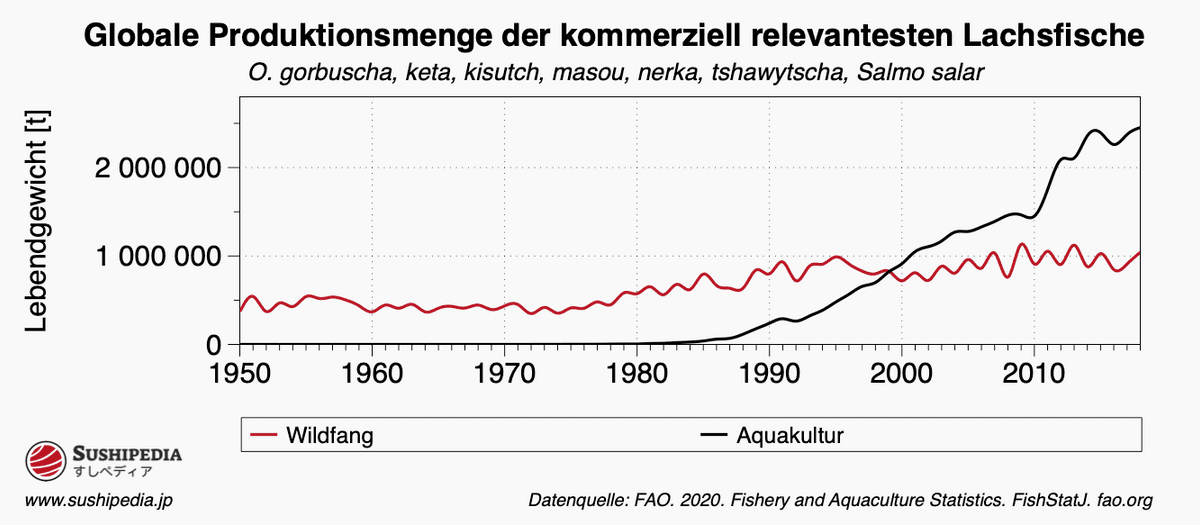
The Atlantic salmon is one of the most important food fishes of all, its share of the worldwide quantity of fish from aquaculture was about 4.5% in 2018 according to the Food and Agriculture Organization of the United Nations (FAO). The increase in aquaculture production in recent years has led to a steady rise in per capita consumption rates of salmon. Driven by strong demand in almost all regions of the world, salmon has become the largest single fish product in terms of value. In terms of annual production and export volume, Norway is the global market leader, followed by Chile.
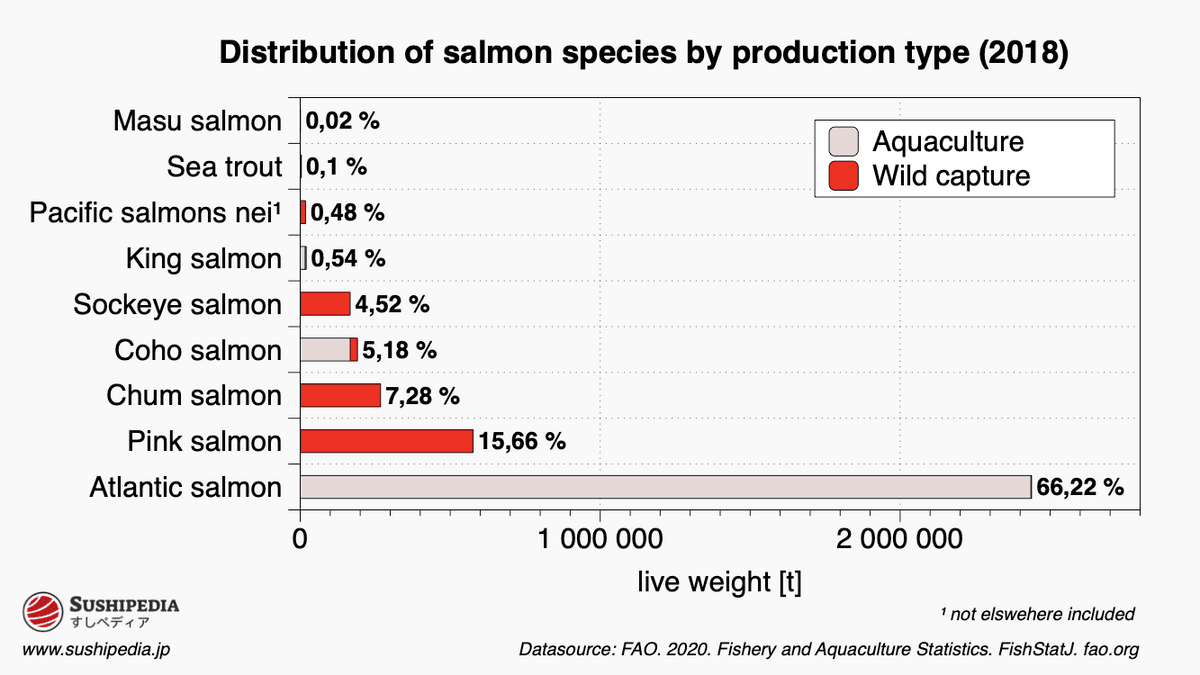
The Risks of Aquaculture
Large industrial aquaculture operations pose a threat to wild populations of salmonids living in close proximity to farms. Due to the construction design of the net cages, as well as the weather conditions in the bays, a large number of salmon escape from farms every year. These escaped salmon can have a significant impact on wild relatives or other fish species. In addition to competition for food and spawning habitats, the crossing of wild and farmed salmon is considered one of the greatest threats to native wild stocks. The genetic weakening of wild populations leads to the spread of disease and the disruption or complete cessation of natural migration. Already in the 1990s, escaped farmed salmon accounted for an estimated 22% of wild catches [Clay, 2004], [Staniford, 2001]. In Norwegian rivers, farmed salmon represent on average between 11% and 34% of the annual spawning population [Jonsson & Jonsson, 2011], [Fiske et al., 2001], [Naylor & Burke, 2005].
Video about Sake
External video embedded from youTube.com: 東京すしアカデミー寿司職人養成学校. How to make Sushi Salmon│How to filet salmon│Tokyo sushi academy(東京すしアカデミー)
Distribution Area of Sake
Source: Kaschner, K., Kesner-Reyes, K., Garilao, C., Segschneider, J., Rius-Barile, J. Rees, T., & Froese, R. (2019, October). AquaMaps: Predicted range maps for aquatic species. Retrieved from https://www.aquamaps.org. Scarponi, P., G. Coro, and P. Pagano. A collection of Aquamaps native layers in NetCDF format. Data in brief 17 (2018): 292-296.
Warnings Regarding Sake Sushi or Sashimi
- PARASITES: The meat, especially that of wild-caught specimens, may be infested with parasites that cause infectious diseases. Infection can be avoided if the raw meat has been adequately frozen. Pickling and soaking in salt or vinegar solution is not sufficient to eliminate the parasites. If the product has been farmed, only raw unprocessed seafood from production facilities whose products are approved for raw consumption should be consumed. [FDA, 2021]
- PHARMACEUTICAL RESIDUES: The use of unauthorized drugs or misuse of authorized drugs in seafood aquaculture poses a potential risk to human health. Only eat raw seafood from production facilities whose products are approved for raw consumption. [FDA, 2021]
Species of Sake
The following species are regarded as authentic. Either historically, according to the area of distribution or according to the common practice in today's gastronomy:
Japanese Name | Common Names, Scientific Name |
|---|---|
benizake, himemasu ベニザケ、ヒメマス | blue-back, blueback salmon, fraser river salmon Oncorhynchus nerka family: Salmonidae |
ginzake, ginmasu ギンザケ、ギンマス 銀鮭 | coho salmon, coho(=silver) salmon, hooknose Oncorhynchus kisutch family: Salmonidae |
karafutomasu カラフトマス | humpback salmon, humpy, pink salmon Oncorhynchus gorbuscha family: Salmonidae |
masunosuke マスノスケ | blackmouth, chinook, chinook salmon Oncorhynchus tshawytscha family: Salmonidae |
sake, shiro-sake サケ、シロサケ 白鮭、鮭 | calico salmon, chum salmon, dog salmon Oncorhynchus keta family: Salmonidae |
sakuramasu, amago サクラマス、アマゴ | Japanese salmon, cherry salmon, masu salmon Oncorhynchus masou family: Salmonidae |
taiseiyousake, atorantikku samon タイセイヨウサケ、アトランチックサモン 大西洋サケ、大西洋鮭 | atlantic salmon, black salmon, common atlantic salmon Salmo salar family: Salmonidae |
The following species can be considered subsitutes. Either on the basis of genetic relationship or because they are similar in taste or appearance:
Japanese Name | Common Names, Scientific Name |
|---|---|
torautosamon トラウトサモン | Coastal rainbow trout, steelhead Oncorhynchus mykiss irideus family: Salmonidae |
References & Further Reading
- [Asche & Bjorndal, 2011]: Frank Asche, Trond Bjorndal. The Economics of Salmon Aquaculture. John Wiley & Sons, Hoboken. 2011.
- [Clay, 2004]: Jason Clay. World Agriculture and the Environment: A Commodity-By-Commodity Guide To Impacts And Practices. Island Press, Washington, D.C.. 2004.
- [FDA, 2021]: Fish and Fishery Products Hazards and Controls Guidance, Fourth Edition – June 2021. U.S. Department of Health and Human Services, Food and Drug Administration Center for Food Safety and Applied Nutrition. 2021.
- [Fiske et al., 2001]: Fiske P., Lund R. A., Ostborg G. M., Floystad L.. Escapes of reared salmonin coastal and marine fisheries in the period 1989–2000. NINA Oppdragsmelding. Source.Volume 704. Norwegian Institute for Nature Research (NINA), Trondheim. 2001.
- [Jonsson & Jonsson, 2011]: Bror Jonsson, Nina Jonsson. Ecology of Atlantic Salmon and Brown Trout: Habitat as a template for life histories. Springer Science & Business Media, Heidelberg. 2011.
- [Kamoey, 2015]: Andreas Kamoey. The Japanese Market for Seafood. GLOBEFISH. Source.Volume 117. Food and Agriculture Organization of the United Nations (FAO), Rome. 2015.
- [MAFF, 2012]: サケは赤身の魚ですか (engl. Is salmon a lean fish?). Ministry of Agriculture, Forestry and Fisheries, Tokyo (農林水産省、東京市). 2012. https://www.maff.go.jp/j/heya/sodan/1203/a03.html. Retrieved online on December 26, 2020.
- [Mitsutaku, 2011]: Mitsutaku Makino. Fisheries Management in Japan - Its institutional features and case studies. Springer Science+Business Media, Heidelberg. 2011.
- [Naylor & Burke, 2005]: R. Naylor, M. Burke. Aquaculture And Ocean Resources: Raising Tigers of the Sea. Annual Review of Environment and Resources. Source.Volume 30. Annual Reviews, Palo Alto. 2005.
- [Onodera, 2020]: 小野寺 桂子. 36℃ 生 v.s. 低温調理サーモン 比較実験 (engl. 36°C raw v.s. low-temperature cooked salmon comparison experiment). boniq.jp, BONIQ, Hayama Shachu Co., Ltd., Kanagawa (株式会社葉山社中、葉山町). 2020. https://boniq.jp/recipe/?post_type=recipe&p=15225. Retrieved online on January 08, 2021.
- [Shibusawa, 1959]: Shibusawa Keizo (言泉). Study of Japanese Fish Names (日本魚名の研究). Kadokawa Shoten, Tokyo (角川書店、東京市). 1959.
- [Soysal, 2014]: Yasemin Nuhoḡlu Soysal. Asia's Transformations: Transnational Trajectories in East Asia: Nation, Citizenship, and Region. Routledge, London. 2014.
- [Staniford, 2001]: Don Staniford. The One that Got Away: Marine Salmon Farming in Scotland. Friends of the Earth Scotland, Edinburgh. 2001.
- [William, 2004]: William Bright. Native American Placenames of the United States. University of Oklahoma Press. 2004.
